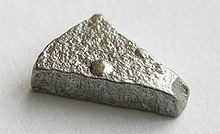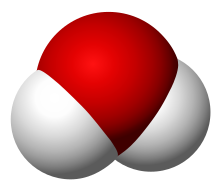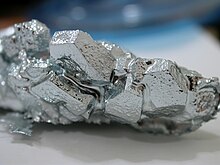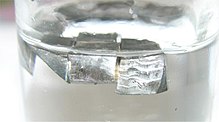Chemical element
A chemical element is a pure substance that can no longer be broken down into other substances using chemical methods. The elements are the basic substances of chemical reactions . The smallest possible amount of an element is the atom . All atoms of an element have the same number of protons in the atomic nucleus (the atomic number ). Therefore they have the same structure of the electron shell and consequently behave chemically in the same way.
An element is denoted by an element symbol , an abbreviation that is mostly derived from the Latin name of the element (e.g. Pb from plumbum , Fe from ferrum ). The elements are arranged in the periodic table in order of increasing atomic number . A total of 118 elements have been verified to date. Of these, the elements with atomic numbers from 1 to 94 occur naturally on earth, but often in the form of chemical compounds and sometimes only in extremely small traces, e.g. B. as short-lived intermediates in radioactive decay . 80 of the 118 known chemical elements have at least one stable nuclide .
history
Concept history
The term chemical element emerged from the 17th century, when it was increasingly recognized that the concept of element in alchemy is unsuitable for a scientific elucidation of the diverse properties of substances and their reactions with one another. Etienne de Clave took a decisive step , who in 1641 gave the definition that elements are "simple substances from which the mixed substances are composed and into which the mixed substances can ultimately be broken down again". Robert Boyle published an influential criticism of the inadequacies of alchemy in 1661 under the title The Skeptical Chymist . In it he stated that one should understand by chemical elements those primitive substances, "which neither originated from other substances nor apart, but form the constituents of which mixed substances consist".
Both researchers thus opposed the prevailing four-element theory of the alchemists , who tried to explain all substances through different mixtures of fire , water , air and earth , and made the term element accessible for closer experimental research. On the other hand, they remained attached to alchemy, assuming that these elements could not occur individually in reality, but that every real substance is a mixture of all elements at the same time. Boyle doubted that such elements even existed. In the spirit of the mechanics emerging at that time , he assumed that the uniformly appearing substances consisted of uniform small particles , which in turn are composed in a well-defined way from the smallest corpuscles . He explained the variety of substances and their reactions through the innumerable possible ways in which the corpuscles can combine to form these particles, which are characteristic of each substance. As a result of a rearrangement of the corpuscles , he also saw the transmutation sought in alchemy as possible, i.e. H. the transformation of one element (e.g. lead ) into another (e.g. gold ).
But Boyle paved the way for Antoine Laurent de Lavoisier , who dismissed the corpuscles as metaphysical speculation, but in 1789 characterized the chemical elements by the fact that they could not be broken down into other substances. More precisely: All substances should be considered elementary , i.e. H. not combined, apply as long as no methods for the further separation of individual components have been found.
Based on this definition, Lavoisier's extraordinarily precise observations of chemical and physical material transformations paved the way for modern chemistry. In particular, he discovered the preservation of the total mass in all material conversions and determined the exact mass ratios in which pure elements react with one another. So John Dalton was led to the law of multiple proportions , which he was able to scientifically justify in 1803 by assuming the existence of immutable and indestructible smallest matter particles, the atoms . According to Dalton, an element is defined by a kind of uniform atoms that can combine with other atoms according to fixed rules. The different behavior of the elements is explained by their atomic species in mass , size and bonding options are different to other atoms. This leads to u. a. the possibility of determining the relative atomic masses of the various elements with one another, which was the first time that atoms became the subject of experimental natural science.
Dalton's approach proved extraordinarily successful in interpreting the chemical reactions and compounds . His definitions of element and atom were therefore retained, even when the assumptions of the immutability of atoms (especially their indivisibility) and the equality of all atoms of the same element were finally refuted by observations on the radioactive elements discovered in 1896 : In 1902 Ernest Rutherford explained in his transmutation theory that radioactive decay series as a result of atomic divisions and further element transformations. In 1910, Frederick Soddy discovered that atoms of the same radioactive element can occur in different series of decays with different mass ( isotopy ). From 1920 these phenomena were found in all elements.
In the first half of the 20th century, the structure of the atom was clarified to the effect that the chemical behavior is largely determined by the negatively charged electron shell of the atom, which in turn is determined by the positive charge of the atomic nucleus . Therefore, today's concept of the chemical element is based on the electrical charge of the atomic nucleus. It is given by the number of protons present in the nucleus , which is therefore called the chemical atomic number of the atom or element.
Looking back on the original definitions for the term element by Clave, Boyle and Lavoisier (see above) and also on Boyle's corpuscles , it seems that the best realizations of these hypothetical ideas at the time are not through today's chemical elements and atoms, but through the atomic building blocks proton, Neutron , electron are given.
Discovery story
In ancient times and well into the Middle Ages , it was believed that the world is made up of the four elements earth , water , air and fire .
Of the elements in the modern sense only ten elements were in antiquity pure form known which either solid occurred or ore to be melted: carbon , sulfur , iron , copper , zinc , silver , tin , gold , mercury and lead. In the course of medieval mining history , especially in the Ore Mountains , small amounts of admixtures of unknown metals were discovered in ores and named after mountain spirits ( cobalt , nickel , tungsten ). The discovery of phosphorus by Hennig Brand in 1669 finally ushered in the age of the discovery of most elements, including uranium from pitchblende by Martin Heinrich Klaproth in 1789.
Before 1751, the following 9 sub-group elements were known: iron , cobalt , nickel , copper , zinc , silver , platinum , gold and mercury , as well as the 8 main group elements carbon , phosphorus , sulfur , arsenic , tin , antimony , lead and bismuth . In 1751 a total of 31 elements were known.
From 1751 to 1800, 13 more elements were added: hydrogen , titanium , chromium , manganese , yttrium , zirconium , molybdenum , tungsten , uranium , nitrogen , oxygen , chlorine and tellurium .
In the period from 1800 to 1830 a total of 22 new elements were discovered: the subgroup elements vanadium , tantalum , rhodium , palladium , cadmium , osmium , iridium and the rare earth thorium , as well as the main group elements lithium , beryllium , sodium , magnesium , potassium , Calcium , strontium , barium , boron , aluminum , silicon , selenium , iodine and bromine .
Eleven other elements were added between 1830 and 1869. They were also a marker for the state of technical and scientific development, because difficult to find and rare elements were discovered and described. They were helium , rubidium , cesium , indium , thallium , niobium , ruthenium , lanthanum , cerium , terbium , erbium . Thus, by the year 1869, 77 elements had been discovered.
In the course of the 19th century the rare earth metals were discovered, with which almost all naturally occurring elements were known. During this time, many hypothetical elements were postulated that were later rejected, such as the nebulium . In the 20th and the beginning of the 21st century, many elements that did not occur in nature - the transuranic elements - were artificially produced, partly in nuclear reactors and partly in particle accelerators . What all these elements have in common is that they are unstable; That is, they transform into other elements at different rates. The discovery of further such short-lived elements is to be expected; they are only produced in extremely small quantities. The elements received their names from their discoverer, which led to a controversy about naming elements in the 20th century . Elements that have not yet been created or named have systematic element names .
Order system
The elements are arranged according to their atomic number (atomic number) and the electron configuration of their atoms in the periodic table of the elements (PSE) in groups and periods . This system was founded by the Russian scholar Dmitri Iwanowitsch Mendelejew at the same time as the German doctor and chemist Lothar Meyer in 1869.
properties

Chemical elements are identified by means of detection reactions from analytical chemistry.
Many properties of the elements can be derived from the structure of their atoms. Various historical atomic models, especially the successful Bohr shell model , provide the theoretical basis for this.
All atoms of an element in the electrically uncharged state have as many electrons in the electron shell as there are protons in the atomic nucleus. If the elements are arranged according to the increasing number of protons ( atomic number ) in the so-called periodic system , periodically recurring properties result (see main group , subgroup ).
In chemical reactions, only the electrons on the outer shells of the reactants are rearranged, the atomic nucleus, however, remains unchanged. Atoms primarily "seek" the so-called noble gas configuration (stability due to the closed outer shell), even if this is at the expense of electrical neutrality , and only secondarily strive for charge equalization of the overall configuration . This “striving” is described by electronegativity . Noble gases , i.e. elements with an outer shell that is closed in a neutral state, are poorly reactive and only form compounds under drastic conditions.
A unique "identification" of the electrons of an element provides the quantum number Quartet : principal quantum number , quantum number , the magnetic quantum number , spin quantum number , ie quantum physical element properties.
Isotopes, nuclides
All atoms of the same element have the same number of protons, but they can contain different numbers of neutrons . These species, which only differ in their number of neutrons, are the isotopes of the element concerned. The general name for a type of atom determined by the number of protons and the number of neutrons is nuclide .
There are , for example, three isotopes of hydrogen in natural occurrences: protium (no neutrons), deuterium (1 neutron), and tritium (2 neutrons). The nucleus of the most common isotope of hydrogen (Protium, 99.9851%) consists of a single proton. Deuterium occurs in natural hydrogen with a share of 0.0149%, tritium with <10 −10 %.
The most common helium atomic nucleus consists of two protons and two neutrons. There is also the isotope , helium-3 , whose nucleus contains only one neutron , in natural occurrences with a share of only 0.000137% .
Natural chlorine (17 protons) consists of a mixture of isotopes with 18 neutrons (75.8%) and 20 neutrons (24.2%).
Dimensions

The atomic masses of the isotopes are approximate , but not exactly, integer multiples of the mass of the hydrogen atom . The reasons for these deviations, which are less than 0.9 percent, are:
- The binding energy of the atomic nucleus components shows up as a mass defect , so that the nuclear mass is always slightly smaller than the sum of the masses of the core components. This effect reaches its maximum in the area of iron and nickel cores with 0.945 percent.
- Atomic nuclei consist of protons and neutrons . Neutrons are 0.138 percent heavier than protons.
- In the electrically neutral atom, protons only occur together with the same number of electrons that have 0.055 percent of the proton mass.
The last two effects only partially compensate each other.
Pure and mixed elements

Chemical elements that only have one kind of atom in their natural occurrence are called pure elements ; on the other hand, if they consist of two or more isotopes, they are called mixed elements . Most of the elements are mixed elements. There are 19 stable and three long-lived unstable pure elements ( bismuth , thorium and plutonium ), for a total of 22 pure elements.
In the periodic table, the average atomic mass for mixed elements according to the relative abundances of the isotopes stands. The natural mixing ratio is mostly constant for one element, but can fluctuate locally for some elements. Lead, for example, shows different average atomic masses depending on its origin ( deposit ). 2010 decided to IUPAC that in the future for the elements hydrogen , boron , lithium , carbon , nitrogen , oxygen , silicon , sulfur , chlorine and thallium in the periodic table, the mass as a mass range to be indicated.
A strict distinction must be made between the terms pure substance and pure element , as well as mixture of substances and mixed element .
Chemical compounds
With the exception of a few noble gases, chemical elements can enter into chemical compounds . Several of the elementary atoms are combined to form molecules or ion crystals .
Elements can form a compound with other elements or with themselves: With many gases such as chlorine Cl or fluorine F, two atoms of the same element combine to form a molecule, here Cl 2 and F 2 . In addition to O 2 , oxygen also forms less stable triatomic O 3 molecules, sulfur forms ring-shaped from six to eight atoms. Ordinary water ( empirical formula : H 2 O), on the other hand, is a combination of the elements hydrogen H (2 atoms per molecule) and oxygen (1 atom per molecule).
There are basically three types of chemical bonds between the atoms of the elements:
- Molecular compounds arise from non-metal and non-metal - they are non-conductors (electrically non-conductive) with mostly relatively low boiling points ( with the exception of diamond-like or plastic -like compounds with giant molecules ). In addition to water , examples of molecular compounds are methane and sugar .
- Ionic compounds arise from metal ( cation ) and non-metal ( anion ). They are salty : brittle , often with a high melting point and electrically conductive in melt or solution . Examples of ionic compounds are iron (II) oxide and common salt ( sodium chloride ).
- Metallic compounds are created from two or more metals. The metal atoms are connected here by metallic bonds and often by additional ionic or covalent bond components. They are not to be confused with alloys .
The creation of elements

The light elements hydrogen (approx. 75%) and helium (approx. 25%) were created as early as the Big Bang , together with small amounts of lithium and beryllium . At the beginning of cosmochemistry, there is hydrogen with a relative atomic mass of approx. 1.0 u (one proton). Heavier elements arise in the universe through nuclear reactions in the stars . In main sequence stars like our sun , for example, four hydrogen atom nuclei fuse under high temperature (several million degrees Celsius) and high pressure via several intermediate stages to form a helium atom nucleus (relative atomic mass approx. 4.0 u ). This is a little lighter than the four protons put together, the mass difference is released as energy .
This fusion (atoms with a lower number of protons fuse to form higher ones) continues in most stars to the formation of carbon, in massive stars to the formation of iron , the most densely packed atomic nucleus. This always takes place with the release of energy, whereby the energy yield decreases with increasing atomic number of the formed elements up to iron. The fusion reactions to heavier nuclei would require an input of energy.
Elements that are heavier than iron are therefore not created by nuclear fusion , but by neutron capture of existing atoms, which are converted into elements with a higher atomic number. With low-mass stars this happens in the so-called s-process , with massive stars at the end of the lifespan of stars during a supernova in the r-process .
The resulting elements enter the interstellar medium (continuously through solar wind or explosively in a supernova) and are available for the formation of the next generation of stars or other astronomical objects . Younger star systems therefore contain small amounts of heavier elements right from the start , which can form planets like in our solar system .
Chemical elements statistics
Of the 118 known elements (as of 2015), 80 are stable. All stable elements occur naturally on earth, as well as 14 radioactive ones (see element abundance ). Other radioactive elements have been artificially produced, and their number is likely to continue to increase.
The elements can be divided according to various criteria. The most common is the subdivision into those elements that form metals and make up the majority of the elements, as well as into non-metals and the intermediate stage semi-metals .
Only 17 of all elements belong to the group of non-metals; these do not form metals under standard conditions . Of these, the six noble gases are monatomic because their atoms do not form molecules, i. H. do not react to each other. In contrast, others combine with atoms of the same element to form molecules. These include the other five elements that are gaseous under normal conditions : hydrogen (H 2 ), nitrogen (N 2 ), oxygen (O 2 ), fluorine (F 2 ) and chlorine (Cl 2 ) as well as liquid bromine (Br 2 ) and solid Iodine (I 2 ).
Abundance of chemical elements


The abundance of the chemical elements differs depending on the area under consideration.
In the universe it is closely linked to the creation processes in the cosmological time frame ( nucleosynthesis ). By far the most common element there is hydrogen, followed by its simplest fusion product, helium, both of which were formed soon after the Big Bang . The next most common elements are carbon and oxygen . Lithium, beryllium and boron were also formed during the Big Bang, but in much smaller quantities.
Helium, carbon and oxygen as well as all other types of atoms were formed by nuclear fusion in stars or by other astrophysical processes. Atoms with an even number of protons , such as oxygen, neon, iron or sulfur, were formed more frequently , while elements with an odd number of protons are rarer. This rule is for the US chemist William Draper Harkins (1873-1951) Harkinssche usually called. The particular frequency of iron as the end point of possible nuclear fusion in stars is striking .
The distribution on earth differs from that which prevails in the entire universe. In particular, comparatively small amounts of hydrogen and helium are present on earth because these gases cannot be held in place by the earth's gravitational field ; in the solar system they are mainly found in the gas planets such as Jupiter and Neptune . On rocky planets like Earth, the heavier elements predominate, especially oxygen, silicon, aluminum and iron.
Organisms mainly consist of hydrogen , oxygen , carbon and nitrogen .
Elements that occur very frequently in the area under consideration are referred to as bulk elements , and very rare ones as trace elements .
Classification in the scheme of chemical substances
| Schematic classification of the substances | |||||||||||||||||||||||||||||||||||||||||||||||||||||||||||||||||||||||||||||||||||||||||||||||||||||||||||||||||||||||||||||||||||||||||||||||||||||||||||||||||||||||||||||||||||||||||||||||||||||||||||||||||||||||||||||||||||||||||||||||||||||||||||||||||||||||||||||||||||||||||||||||||||||||||||||||||||||||||||||||||||||||||||||||||||||||||||||||||||||||||||||||||||||||||||||||||||||||||||||||||||||||||||||||||||||||||||||||||||||||||||||||||||||||||||||||||||||||||||||||||||||||||||||||||||||||||||||||||||||||||||||||||||||||||||||||||||||||||||||||||||||||||||||||||||||||||||||||||||||||||||||||||||||||||||||||||||||||||||||||||||||||||||||||||||||||||||||||||||||||||||||||||||||||||||||||||||||||||||
|---|---|---|---|---|---|---|---|---|---|---|---|---|---|---|---|---|---|---|---|---|---|---|---|---|---|---|---|---|---|---|---|---|---|---|---|---|---|---|---|---|---|---|---|---|---|---|---|---|---|---|---|---|---|---|---|---|---|---|---|---|---|---|---|---|---|---|---|---|---|---|---|---|---|---|---|---|---|---|---|---|---|---|---|---|---|---|---|---|---|---|---|---|---|---|---|---|---|---|---|---|---|---|---|---|---|---|---|---|---|---|---|---|---|---|---|---|---|---|---|---|---|---|---|---|---|---|---|---|---|---|---|---|---|---|---|---|---|---|---|---|---|---|---|---|---|---|---|---|---|---|---|---|---|---|---|---|---|---|---|---|---|---|---|---|---|---|---|---|---|---|---|---|---|---|---|---|---|---|---|---|---|---|---|---|---|---|---|---|---|---|---|---|---|---|---|---|---|---|---|---|---|---|---|---|---|---|---|---|---|---|---|---|---|---|---|---|---|---|---|---|---|---|---|---|---|---|---|---|---|---|---|---|---|---|---|---|---|---|---|---|---|---|---|---|---|---|---|---|---|---|---|---|---|---|---|---|---|---|---|---|---|---|---|---|---|---|---|---|---|---|---|---|---|---|---|---|---|---|---|---|---|---|---|---|---|---|---|---|---|---|---|---|---|---|---|---|---|---|---|---|---|---|---|---|---|---|---|---|---|---|---|---|---|---|---|---|---|---|---|---|---|---|---|---|---|---|---|---|---|---|---|---|---|---|---|---|---|---|---|---|---|---|---|---|---|---|---|---|---|---|---|---|---|---|---|---|---|---|---|---|---|---|---|---|---|---|---|---|---|---|---|---|---|---|---|---|---|---|---|---|---|---|---|---|---|---|---|---|---|---|---|---|---|---|---|---|---|---|---|---|---|---|---|---|---|---|---|---|---|---|---|---|---|---|---|---|---|---|---|---|---|---|---|---|---|---|---|---|---|---|---|---|---|---|---|---|---|---|---|---|---|---|---|---|---|---|---|---|---|---|---|---|---|---|---|---|---|---|---|---|---|---|---|---|---|---|---|---|---|---|---|---|---|---|---|---|---|---|---|---|---|---|---|---|---|---|---|---|---|---|---|---|---|---|---|---|---|---|---|---|---|---|---|---|---|---|---|---|---|---|---|---|---|---|---|---|---|---|---|---|---|---|---|---|---|---|---|---|---|---|---|---|---|---|---|---|---|---|---|---|---|---|---|---|---|---|---|---|---|---|---|---|---|---|---|---|---|---|---|---|---|---|---|---|---|---|---|---|---|---|---|---|---|---|---|---|---|---|---|---|---|---|---|---|---|---|---|---|---|---|---|---|---|---|---|---|---|---|---|---|---|---|---|---|---|---|---|---|---|---|---|---|---|---|---|---|---|---|---|---|---|---|---|---|---|---|---|---|---|---|---|---|---|---|---|---|---|---|---|---|---|---|---|---|---|---|---|---|---|---|---|---|---|---|---|---|---|---|---|---|---|---|---|---|---|---|---|---|---|---|---|---|---|---|---|---|---|---|---|---|---|---|---|---|---|---|---|---|---|---|---|---|---|---|---|---|---|---|---|---|---|---|---|---|---|---|---|---|---|---|---|---|---|---|---|
|
|||||||||||||||||||||||||||||||||||||||||||||||||||||||||||||||||||||||||||||||||||||||||||||||||||||||||||||||||||||||||||||||||||||||||||||||||||||||||||||||||||||||||||||||||||||||||||||||||||||||||||||||||||||||||||||||||||||||||||||||||||||||||||||||||||||||||||||||||||||||||||||||||||||||||||||||||||||||||||||||||||||||||||||||||||||||||||||||||||||||||||||||||||||||||||||||||||||||||||||||||||||||||||||||||||||||||||||||||||||||||||||||||||||||||||||||||||||||||||||||||||||||||||||||||||||||||||||||||||||||||||||||||||||||||||||||||||||||||||||||||||||||||||||||||||||||||||||||||||||||||||||||||||||||||||||||||||||||||||||||||||||||||||||||||||||||||||||||||||||||||||||||||||||||||||||||||||||||||||
See also
literature
- Theodore Gray: The Elements. Fackelträger-Verlag, Cologne 2009, ISBN 978-3-7716-4435-2 .
- Ulf von Rauchhaupt : The order of matter. A journey through the world of chemical elements. Fischer Taschenbuch Verlag, Frankfurt am Main 2009, ISBN 978-3-596-18590-0 .
- Lucien F. Trueb: The chemical elements - A foray through the periodic table. S. Hirzel Verlag, Stuttgart 2005, ISBN 3-7776-1356-8 .
- Harry H. Binder: Lexicon of the chemical elements - the periodic table in facts, figures and data. Hirzel, Stuttgart 1999, ISBN 3-7776-0736-3 .
- Alexander C. Wimmer: The chemical elements. SMT, Leoben 2011, ISBN 978-3-200-02434-2 .
Web links
- www.chemieseite.de contains detailed descriptions of the main elements
- www.pse-mendelejew.de contains many photographs of pure elements
- www.pse.merck.de contains a rich selection of atomic properties in an interactive table
- Comprehensive overview
Individual evidence
- ^ Marie Boas: Robert Boyle and the seventeenth century chemistry . Cambridge University Press, Cambridge 1958, ISBN 978-0-527-09250-4 . (Reprint)
- ^ William H. Brock: Viewegs Geschichte der Chemie . Vieweg, Braunschweig 1992, ISBN 978-3-528-06645-1 .
- ↑ Michael E. Wieser, Tyler B. Coplen: Atomic weights of the elements 2009 (IUPAC Technical Report). In: Pure and Applied Chemistry . 2010, p. 1, doi: 10.1351 / PAC-REP-10-09-14 .










